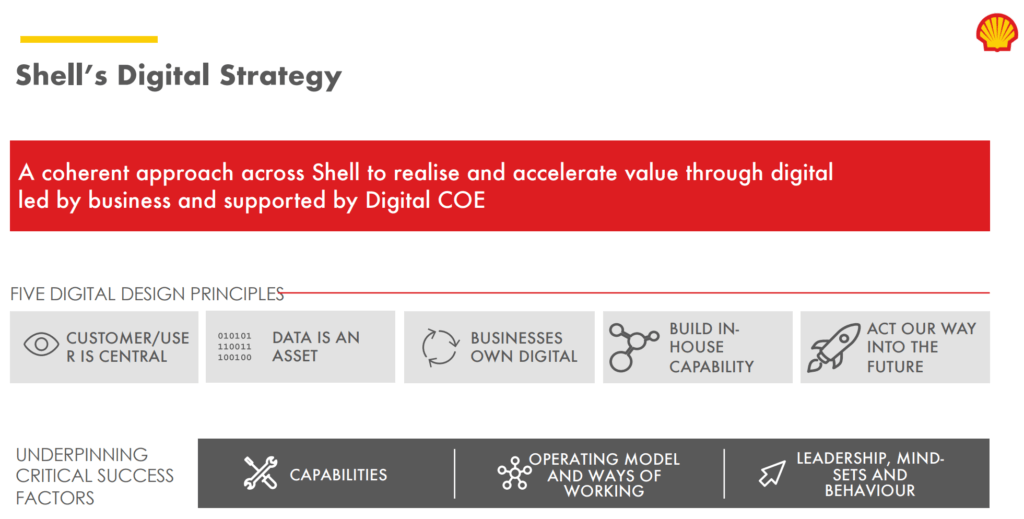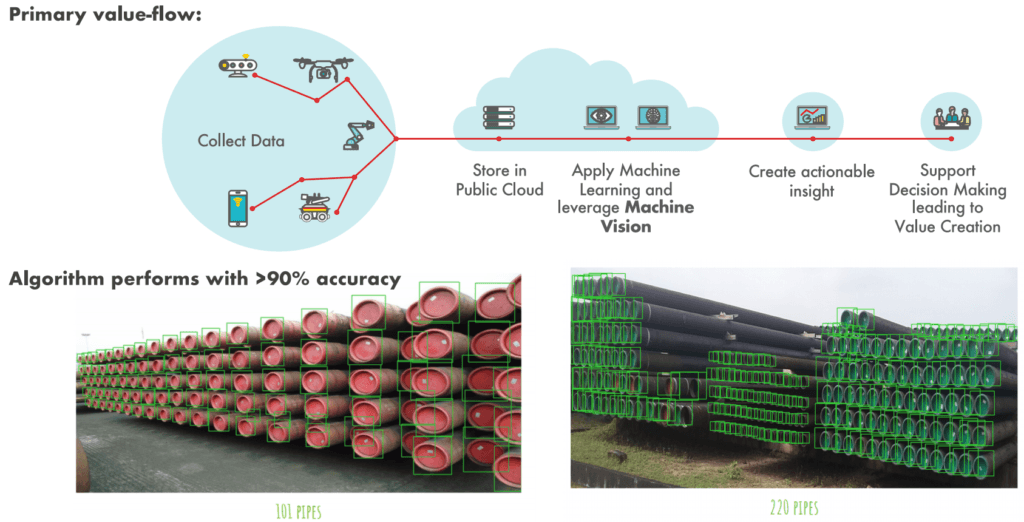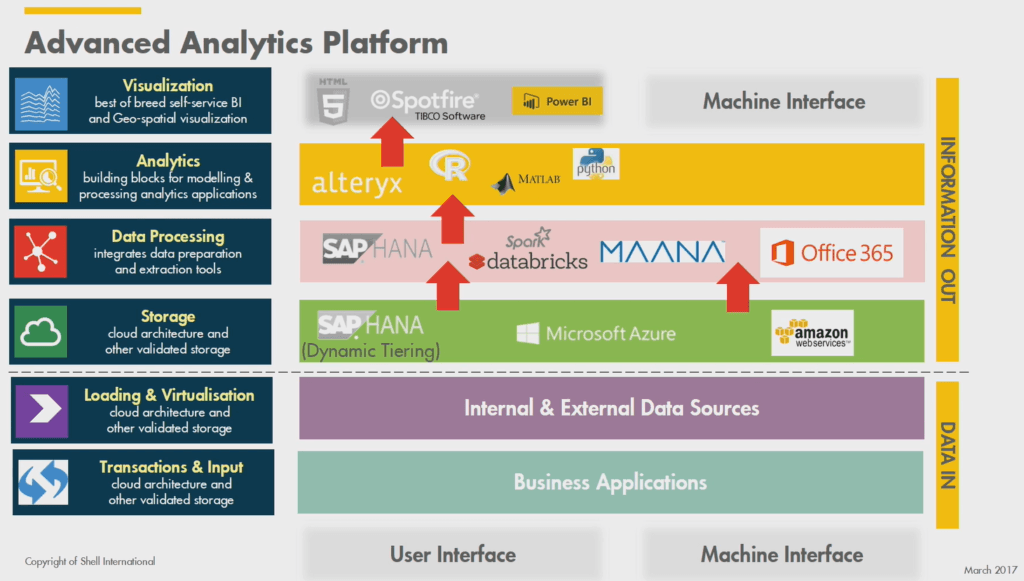Pushing the mantra “data is the new oil” to the limit

Shell, the international energy company, has been an early adopter of data analytics in order to identify potential for improvement in the evolving energy industry. The company constantly tries to innovate, and it does not hold back from investing heavily in advanced technologies to reinvent the way it does business.
Scaling Advanced  Analytics
Analytics
Shell, the international energy company, has been an early adopter of data analytics in order to identify potential for improvement in the evolving energy industry. The company constantly tries to innovate, and it does not hold back from investing heavily in advanced technologies to reinvent the way it does business.
The company digital strategy is built around 5 pillars (see table on the right) [1] and Shell gives the execution of this strategy to its Advanced Analytics Centre of Excellence.
Navigating the midst of uncertainty
Shell currently operates in 70+ countries and produces the equivalent of 3.7 million barrels of oil every day [2]. Efficiently managing such a behemoth inevitably requires insights at different levels of the value chain.
Shell invests heavily in research and development every year—$986 million in 2018 [2]—with the goals of developing talent, crafting innovative tools, such as machinery sensors and production monitoring systems, and ultimately gathering additional data from ground operations. To analyze such vast data, the company also created its own Advanced Analytics platform (see description below [8]), which includes software from many vendors, combined into an efficient ecosystem that helps Shell’s data scientists generate business insights.
A diverse portfolio of applications
An improvement in exploration site selection
To evaluate potential drilling sites, Shell monitors low-frequency seismic activity in the ground through probes filled with sensors and special fiber optic cables developed in partnership with Hewlett Packard. This technology arms Shell with more than a million ground readings per study to help the company’s geologists accurately evaluate each drilling site [4]. Once a site has been selected, these readings also contribute to analyzing the soil content and efficiently selecting what resources to spend on extraction, eliminating the guesswork.
Real-time production control
Shell gathers real-time data points to continuously monitor its production efficiency. If a process’s performance moves outside the pre-established control parameters, the company’s quality control department is automatically alerted of the performance gap. Employees can then rapidly diagnose the issue and fix it, avoiding losses of efficiency or even costly line stoppages, “which can account for tens of millions of dollars in increased gas and oil production” [5].
Preventive machine maintenance
Oil drilling equipment is expensive and, because of the rough conditions of use, tends to be more susceptible to failure than other industrial equipment. On a single day, machine downtime can cost Shell millions of dollars. To prevent critical failure, the company continuously runs predictive models fed with real-time production data. This enables Shell to anticipate “when more than 3,000 different oil drilling machine parts might fail” [3].
Procurement and supply chain optimizations
With operations in 70+ countries, Shell must manage complex procurement processes and an even more complex supply chain. The company uses a combination of predictive models and commercial software to optimize on both fronts:
- The supply chain department uses Alteryx’s platform to provide “critical information on inventory, margin, forecast accuracy, and blending options” [6], allowing the company to be fully in control of all downstream’s operations.
- The procurement department uses Databricks—software hosted in the Microsoft Azure cloud— to optimize when to purchase new parts and where to store them. The tool has proven particularly powerful as it has “reduced inventory analysis from over 48 hours to less than 45 minutes, shaving millions of dollars a year off the cost of moving and reallocating inventory” [3]. (see example of pipe counting and grey stock identification below, [8])

Other applications
Shell makes the most of the vast data it is now able to acquire. The company applies data analytics to [8]:
- assuring trading compliance,
- understanding contractual spend,
- assessing digital marketing performances
A challenging future
The energy industry has rapidly evolved over recent years, principally due to the public’s increasing environmental concerns. Shell, while maintaining its core competencies, needs to respond to that transformation and explore new sources of energy, such as shale gas, tight oil, and renewable energy.
To exploit these new opportunities, the company will have to develop new extraction methods and new predictive models in an environment in which historical data is nonexistent. To double down and invest in these new opportunities will bring a lower ROI than its current operations—in the short term, at least, and until technology improves. However, while the decision to invest in research and development is necessary for the company to avoid losing its position as a pioneer, the reward of an effective, scalable, and profitable new way to produce energy seems far away.
The company’s management seems to understand the dilemma, but will the market reward such behavior or instead penalize its innovative spirit?
SOURCES
[1] https://www.slideshare.net/databricks/scaling-advanced-analytics-at-shell-with-krishna-somasundaram-and-bryce-bartmann?, accessed on 11/2/2019
[2] https://www.shell.com/about-us/who-we-are.html, accessed on 11/2/2019
[3] https://www.cio.com/article/3221621/6-data-analytics-success-stories-an-inside-look.html, accessed on 11/2/2019
[4] https://www.forbes.com/sites/bernardmarr/2015/05/26/big-data-in-big-oil-how-shell-uses-analytics-to-drive-business-success/#3ce15059229e, accessed on 11/2/2019
[5] http://analytics-magazine.org/shell-drills-into-big-data-analytics-2/, accessed on 11/2/2019
[6] https://conferences.oreilly.com/strata/strata-eu-2018/public/schedule/detail/65331, accessed on 11/2/2019
[7] https://hbr.org/2013/05/living-in-the-futures, accessed on 11/2/2019
[8] Shell – Striking (Liquid) Gold with Self Service Advanced Analytics – Inspire Europe 2017, https://www.youtube.com/watch?v=LMUHSR-JPTo, accessed on 11/2/2019




I participated once in the development of a digital strategy for Oil&Gas company.
There were a few other exciting opportunities on the table.
One of them is a real-time drilling assistant that captures the data during the drilling and assists the operator. Due to the huge cost of the process, there were substantial savings.
Another idea was digital storage for soil and rock samples that bring the significant cost in processing, storage, and transmission of samples.